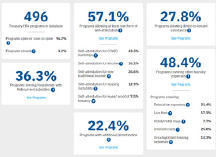 To respond to the COVID-19 crisis, Congress passed two laws to fund the U.S. Department of the Treasury Emergency Rental Assistance (ERA) Program, totaling $46.55 billion. The Treasury ERA program has given funding to states (including the District of Columbia), territories, Tribal governments, and local governments to disburse to landlords and renters in need. NLIHC tracks and analyzes information on each jurisdiction’s program and shares best practices to make sure the $46.55 billion of funding are equitably distributed. Visit NLIHC’s Rental Assistance webpage to find your local ERA program (https://nlihc.org/rental-assistance).
To respond to the COVID-19 crisis, Congress passed two laws to fund the U.S. Department of the Treasury Emergency Rental Assistance (ERA) Program, totaling $46.55 billion. The Treasury ERA program has given funding to states (including the District of Columbia), territories, Tribal governments, and local governments to disburse to landlords and renters in need. NLIHC tracks and analyzes information on each jurisdiction’s program and shares best practices to make sure the $46.55 billion of funding are equitably distributed. Visit NLIHC’s Rental Assistance webpage to find your local ERA program (https://nlihc.org/rental-assistance).
As of September, NLIHC was tracking nearly 500 ERA programs covering all 50 states, DC, 376 cities and counties, 182 Tribal governments, four U.S. territories, and the Department of Hawaiian Home Lands. These programs represent 98% of the $25 billion provided in the first round of funding.
Programs have been slow to get money out the door. According to NLIHC’s tracking, program administrators spent or obligated $8.4 billion (33.7%) of their ERA 1 allocations as of mid-September. The Department of Treasury (Treasury) recently released ERA spending numbers through the end of August, with programs spending or obligating $7.5 billion and serving approximately 1,400,000 households through that time. Nearly 1.5 million families helped is meaningful progress, but the overall rate of spending of emergency rental assistance remains too slow. Some states and jurisdictions are distributing ERA quickly and well - proving that it’s possible and making states and jurisdictions that aren’t all the more glaring and unacceptable.
To serve tenants more effectively, program administrators need to allow tenants to self-attest to qualifying to eligibility criteria. Self-attestation can replace source documentation and thus reduce barriers for tenants and can also help reduce application processing time for program staff. In addition, program administrators can and should pay tenants directly if landlords are not responsive.
As of September, 57% of programs allow for self-attestation for some eligibility criteria instead of asking for documentation and 28% of programs clearly allowed for payments to be made directly to tenants. More programs must implement these critical measures to ensure they meet federal requirements and to help the most marginalized tenants more efficiently and effectively.
To learn more about the adoption of key program design features, visit NLIHC’s ERA Dashboard